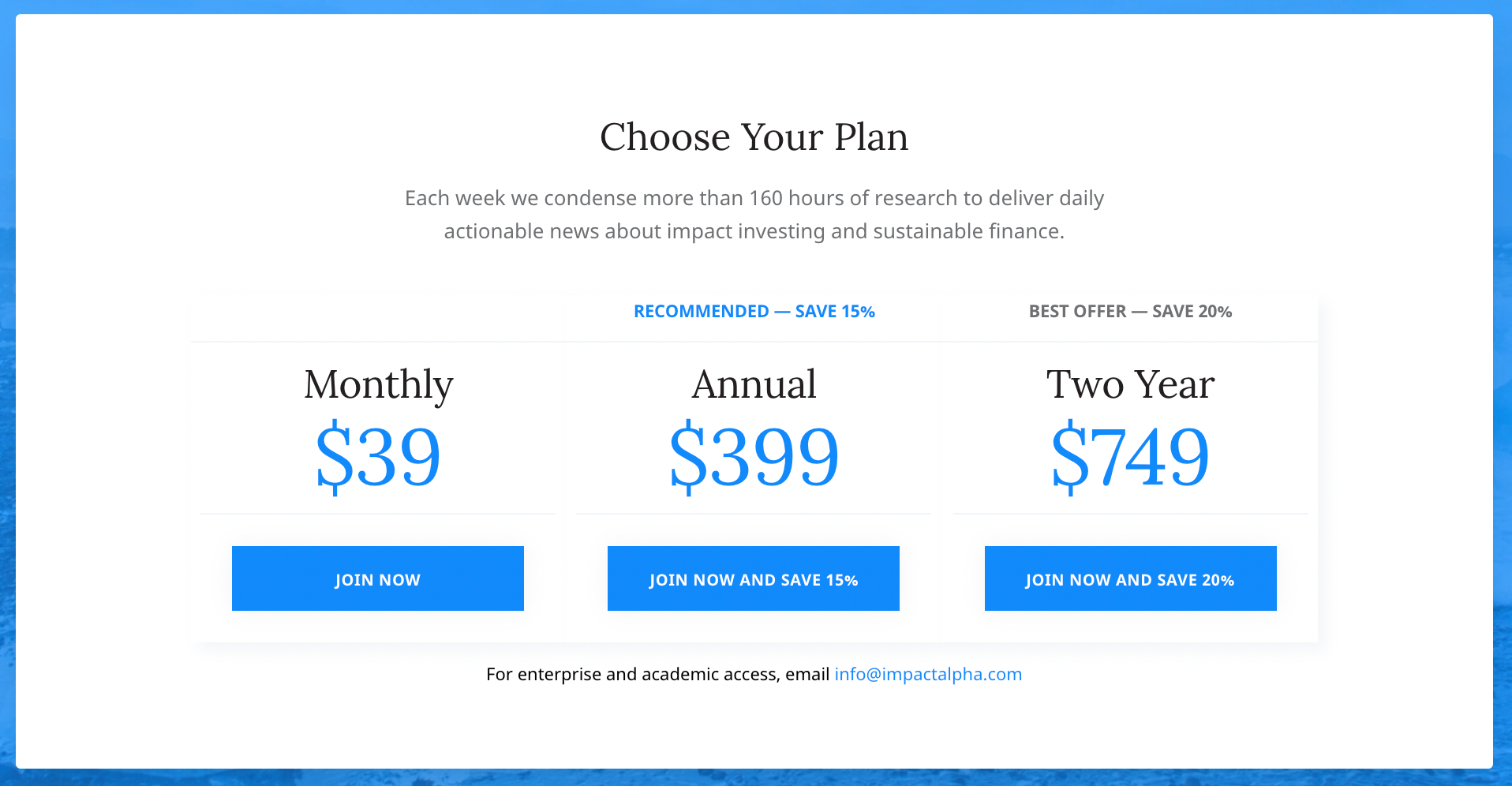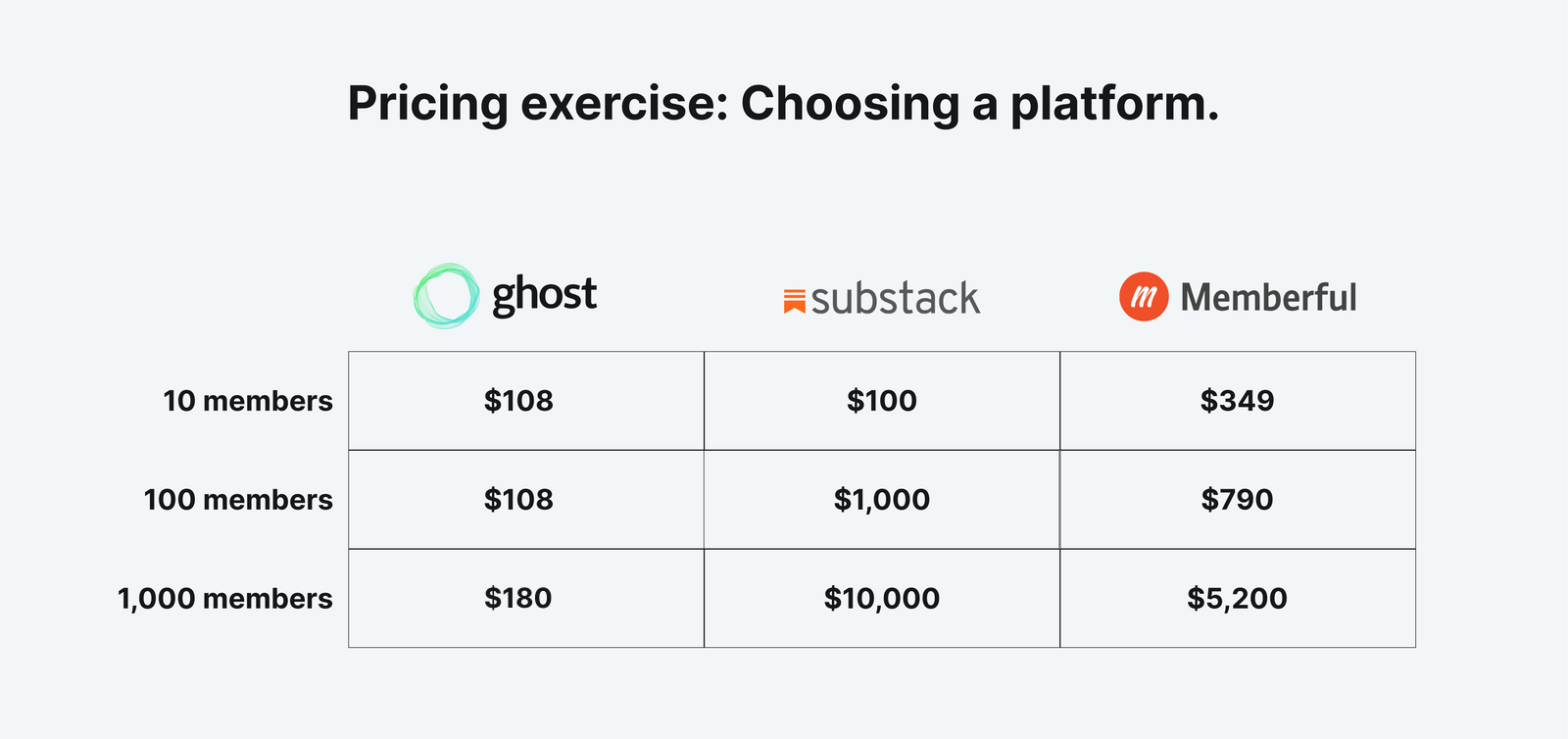4 questions to ask before pricing your subscription newsletter
Most newsletters are priced too low because creators undervalue their work.
Price is the story you tell your customers about the experience they’re about to take part in.
When David Bank, co-founder of the investing newsletter ImpactAlpha, wanted to shift their content from free to paid, they hit a wall. Bank had no idea how much readers would be willing to pay for content they’d been receiving for free.
The plan was always to move toward a premium subscription, but they believed the answers would be clearer when that time came.
They weren’t.
That is until Bank met Jessica E. Lessin, founder of The Information. Bank explained the dilemma, reviewed the research their team had conducted, and settled on the figure of $100 per year as a starting point.
Lessin replied, “One of the general rules of pricing is that people price too low. I would take it to that point that makes you slightly uncomfortable…” (Source)
Lessin's advice was to price ImpactAlpha at $599 per year — a full six times higher than the founder’s initial amount. After some back and forth, they committed to $399 per year, which has since enabled them to grow into a team of 15+ members serving over 70,000 readers globally.

If you’re at the stage of figuring out how to price your newsletter, chances are you’ve run into similar challenges as those mentioned above.
- How can I know how much people are willing to pay?
- If I price too high, will I turn readers away?
- Should I model what other newsletters are doing or try something different?
Most newsletters fall into the $5-15 per month range. But why? There’s no hard and fast rule that says these are the boundaries you must stick to.
ImpactAlpha was able to quadruple their price by answering a few targeted questions.
Pricing a newsletter: A framework
This article offers you a framework to help you price your newsletter like a professional. If you take the time to answer each of the 4 questions for your unique situation, you’ll be surprised by the number you arrive at.
- What is the exact cost to run your newsletter per year?
- What is the quantifiable value a reader gets by subscribing?
- How else do you plan to make money from your content?
- What type of content do you publish and how often?
Question #1 — What is the exact cost to run your newsletter per year?
If you plan to make money with your content, then you must treat it like a real business. Treating it like a business begins with knowing your numbers.
Pricing exercise
A great exercise to conduct when choosing a new platform is to compare costs using the exact figures on each potential tool. In this example, we'll use the following three tiers:
- 10 members (just starting with friends and family)
- 100 members (gaining traction)
- 1,000 members (a growing audience and business)
This way, you'll see how your costs might change over time so you can account for that in pricing. In this example, let’s estimate that you charge your readers an average subscription rate of $100 per year.
How can I conduct this exercise without knowing my actual price first? It’s a classic “chicken or the egg” dilemma. Most newsletter authors don’t take their costs into account until they’re already making money, which can lead to eye-opening results. This question is included first to make sure you keep it in mind, no matter where you might be in the process.
Now let's compare three platforms: Ghost, Substack, and Memberful. Each tool charges a platform fee either in the form of a flat rate or as a percentage of the revenue you earn. There are also standard processing fees, but in this case, all three tools use Stripe which makes their processing fees equal, so these fees are excluded for simplicity.

Ghost
Platform fee: flat rate starting at $9/mo + 0% transaction fees.
- 10 members = $108
- 100 members = $108
- 1,000 members = $180
The nice thing about Ghost is that your fees scale as your business does and there are never any transaction fees, which encourages you to experiment with your pricing (especially on the higher end of the scale).
Substack
Platform fee: free to use, with 10% transaction fees on all of your revenue.
- 10 members = $100
- 100 members = $1,000
- 1,000 members = $10,000
This example illustrates how quickly your costs can skyrocket by not taking into account the fees that you're going to be paying as you grow.
Memberful
Platform fee: flat rate of $300 per year + 4.9% transaction fee on all of your revenue.
- 10 members = $349
- 100 members = $790
- 1,000 members = $5,200
While Memberful scales better than Substack, you can still see how even a moderate transaction fee can significantly eat into your bottom line.
Additional costs you may want to factor in include any tools or software you use to create your content, freelancers, design services, office supplies, co-working fees, computer equipment and so on.
Question #1 deals primarily with the concept of cost-based pricing. This is how most businesses priced goods before the digital era. But as Robbie Baxter, author of The Membership Economy, writes, “Pricing for [digital subscriptions] is not as easy as charging $10 for a product that cost $5 to manufacture.”
That’s why we also need to consider value-based pricing.
Question #2 — What is the quantifiable value a reader gets by subscribing?
The most successful businesses sell value, not products.
In Adam Davidson’s book, The Passion Economy, there's a story of a person who purchased a bulk order of sneakers from the same factory that made Nike. They were convinced this would succeed because the shoes were the same quality as Nike but at half the cost.
Can you guess what happened?
Their garage became a warehouse of unsold shoes for nearly a decade until his wife convinced him to donate the entire lot.
“Price is emotional […] Nike’s marketing people generated a sense of excitement around their shoes, whatever the price. Only a tiny bit of the value they created was in the physical thing; most was in its cultural resonance.”
People who bought Nike shoes were buying into a movement, a look, a tribe. The physical shoes were a manifestation of the value, not the value itself.

In the same way, your newsletter is valuable not because of the word count or layout. Your newsletter’s value is the emotion it invokes in the reader. It’s the money and time it saves every person who opens it. It’s the money made, creativity sparked or opportunity seeded as a result of engaging with your content.
Don’t price your newsletter only according to what it is; price it according to what it helps others do.
A good example of this is the weekly newsletter Exploding Topics. At the cost of $197 per month, they are firmly positioned as a premium newsletter. And yet, they have an avid fanbase because they sell opportunity, not content.
Every week their software helps them identify search trends months before they become mainstream. This information enables content creators, investors and e-commerce professionals to seize these opportunities before they become red oceans.
Capitalizing on a trend before it’s gone mainstream could lead to 6- and 7-figure opportunities, making the premium two-hundred-dollar monthly cost appear negligible.
“Price is determined by the value it provides the customer, not by the raw material that is used to make it.” – Adam Davidson
Question #3 — How else do you plan to make money from your content?
Hunter Walk, investor and partner at the VC firm Homebrew, made waves in the online writer communities when they wrote an article titled “Why a paid newsletter won’t be enough money for most writers (and that’s fine).” Walk's main point went as follows,
“It’s my belief that very few ‘Substack writers’ will make 100% of their income from their newsletter and this won’t be a failure of the platforms but instead related to the nature of creation itself. Enter, the Multi-SKU Creator.”
Walk goes on to explain that similar to how stores carry a variety of products in order to be successful, so creators will learn to diversify their creations and income streams.
“There could be a podcast SKU. A speaking fee SKU. A book deal SKU. A consulting SKU. A guest columnist SKU. And so on.”
This leads to what can be thought of as a web of value.
Your newsletter may be the most important product in your web, but that doesn’t mean it needs to be the only one. Maybe the people who subscribe to your newsletter also get access to a private community. This would be a logical way to both increase the value of what you offer and justify a higher price point.
You could also consider repackaging your most popular articles into a limited edition physical book, thereby creating an additional income stream without producing new content.
Or you could iterate on what The Stratechery has done by creating an audio version of their written newsletter and granting access to it for a few more dollars per month.
The point is to think about your newsletter income as a portion of your web of value. What does it lead to? What channels lead to it? How could you offer your biggest fans something more or something different? How could you give your most casual fans an easier way to contribute?
A strong web may lead you to choose a lower price for your newsletter since you can clearly map out how your audience will generate revenue in other ways. A simpler web may encourage a more premium price since there are fewer alternative income-generating products.
Question #4 — What type of content do you publish and how often?
Kurzgesagt is a YouTube channel run by a German design studio (their name roughly translates to “in a nutshell”), focused primarily on animated explainer videos on scientific topics like climate change and asteroid mining.
As of writing this, their videos have amassed north of 1.3 billion views. On Patreon, they have nearly 15,000 paying patrons.
The best part is they only publish 1 video per month.
How is this possible? Kurzgesagt is known for the highest levels of quality. Each video they produce becomes a gold standard for that particular topic. Only one of their videos in the last year has fewer than 5 million views, and it’s the one announcing their annual limited edition wall calendar (which sold out in minutes).
Kurzgesagt’s goal is virality. Viral content aims to reach the widest swath of people possible so that a portion of them will make an impulse buy (e.g., become a $1 patron). They accomplish this through incredible production with infrequent publishing so that every video gains as much traction as possible.
On the other end of the spectrum is a publication like The Browser, which delivers incredibly high-quality content, but through the medium of a daily email. They’re able to maintain a more demanding publishing schedule by creating an easily digestible templated product: one daily email with five links, each with a summary of less than 100 words.
All of these can and should impact your pricing structure:
- How many people do you intend to reach (millions, thousands, hundreds)?
- How often will you reach them (daily, weekly, monthly)?
- How long will your interactions be (a 200-word article versus a 2,000-word one)?
- How long will it take to produce the content (hours, days, weeks)?
Content with a broader appeal tends to work well with lower-priced offers. Content that demands more of an investment of time or a higher level of subject knowledge works better with a premium structure.
As always, you’re encouraged to break the rules. But it’s helpful to know what they are in the first place.
Additional pricing questions to consider
We’ve covered four questions that will help you position and price your newsletter in a strategic way. Although there are dozens of additional questions one could ask, here are three more worth highlighting.
What are my competitors’ prices?
Comparing your prices to others can be a double-edged sword. On the one hand, it can be helpful to understand what the market conventions are and how much people are used to paying for certain products.
On the other hand, it can lead to price anchoring which means that as you think through your pricing options, you'll focus on how they’re more or less expensive than your competitors instead of focusing on the unique value you provide, apart from what any other creator might be doing.
How low can I go?
Never compete on price. It’s a losing game unless you want to be the absolute biggest name in the game (i.e., Walmart, Amazon). It’s worth remembering that Amazon lost money for ten years before it became the profitable behemoth it is today. Creators can’t (and shouldn’t) play that game.
Price your value, not only your cost.
Do I have to stick with this price forever?
Experimentation is the lifeblood of the creator economy. Listen closely—you’re allowed to change your prices.
You’d be surprised how adaptable dedicated audiences can be. Yes, there may be pushback at times, but at the end of the day, you’re in charge. This is your creation — you make the rules.
Pricing is a challenge, but a fun one
Pricing your newsletter can be an exciting creative challenge. It can open the door to a whole new level of relationship between you and your audience. Remember, people will only respect your work to the level you respect it yourself. No one else can do what you do in the way that you do it.
So take risks, be different, and build for the long term.






